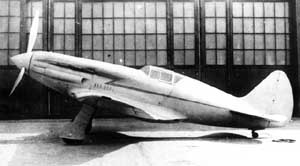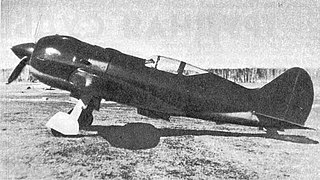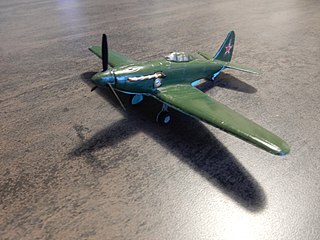The Lavochkin La-5 was a Soviet fighter aircraft of World War II. It was a development and refinement of the LaGG-3, replacing the earlier model's inline engine with the much more powerful Shvetsov ASh-82 radial engine. During its time in service, it was one of the Soviet Air Force's most capable types of warplane, able to fight German designs on almost equal footing.

The Lavochkin La-7 was a piston-engined single-seat Soviet fighter aircraft developed during World War II by the Lavochkin Design Bureau. It was a development and refinement of the Lavochkin La-5, and the last in a family of aircraft that had begun with the LaGG-1 in 1938. Its first flight was in early 1944 and it entered service with the Soviet Air Forces later in the year. A small batch of La-7s was given to the Czechoslovak Air Force the following year, but it was otherwise not exported. Armed with two or three 20 mm (0.8 in) cannon, it had a top speed of 661 kilometers per hour (411 mph). The La-7 was felt by its pilots to be at least the equal of any German piston-engined fighter. It was phased out in 1947 by the Soviet Air Force, but served until 1950 with the Czechoslovak Air Force.

The Mikoyan-Gurevich MiG-1 was a Soviet fighter aircraft of World War II that was designed to meet a requirement for a high-altitude fighter issued in 1939. To minimize demand on strategic materials such as aluminum, the aircraft was mostly constructed from steel tubing and wood. Flight testing revealed a number of deficiencies, but it was ordered into production before they could be fixed. Although difficult to handle, one hundred were built before the design was modified into the MiG-3. The aircraft was issued to fighter regiments of the Soviet Air Forces (VVS) in 1941, but most were apparently destroyed during the opening days of Operation Barbarossa, the German invasion of the Soviet Union in June 1941.

The Mikoyan-Gurevich MiG-3 is a Soviet fighter-interceptor used during World War II. It was a development of the MiG-1 by the OKO of Zavod (Factory) No. 1 in Moscow to remedy problems found during the MiG-1's development and operations. It replaced the MiG-1 on the production line at Factory No. 1 on 20 December 1940 and was built in large numbers during 1941 before Factory No. 1 was converted to build the Ilyushin Il-2.

The Mikoyan-Gurevich MiG-8 Utka was a Soviet experimental aircraft. Built of wood, the aircraft was designed and built in 1945 to test the novel canard configuration. It also used a tricycle undercarriage, the first used by the OKB. It was modified to test a variety of vertical stabilizer and wingtip configurations and was later used as a liaison aircraft for many years by the design bureau.

The Lavochkin La-9 was a Soviet fighter aircraft produced shortly after World War II. It was one of the last piston engined fighters to be produced before the widespread adoption of the jet engine.

The Lavochkin La-11 was an early post-World War II Soviet long-range piston-engined fighter aircraft. The design was essentially that of a Lavochkin La-9 with additional fuel tanks and the deletion of one of the four 23 mm Nudelman-Suranov NS-23 cannons. Like the La-9, the La-11 was designed to be a low to medium-altitude general-purpose fighter, although the additional fuel tanks were added with the intent of employing the La-11 in the escort fighter role.

The Yakovlev Yak-15 is a first-generation Soviet turbojet fighter developed by the Yakovlev design bureau (OKB) immediately after World War II. The main fuselage was that of Yakovlev Yak-3 piston-engine fighter modified to mount a reverse-engineered German Junkers Jumo 004 engine. The Yak-15 and the Swedish Saab 21R were the only two jets to be successfully converted from piston-power to enter production. 280 aircraft were built in 1947. Although nominally a fighter, it was mainly used to qualify piston-engine-experienced pilots to fly jets.

The Mikoyan-Gurevich DIS was a prototype Soviet heavy fighter of World War II, envisioned to serve primarily in the escort fighter role. The service designation MiG-5 was reserved for the production version of the aircraft. Competing designs in the USSR included the Grushin Gr-1, Polikarpov TIS and Tairov Ta-3.

The Shvetsov ASh-82 (M-82) is a Soviet 14-cylinder, two-row, air-cooled radial aircraft engine developed from the Shvetsov M-62. The M-62 was the result of development of the M-25, which was a licensed version of the Wright R-1820 Cyclone.

The Polikarpov I-185 was a Soviet fighter aircraft designed in 1940. It was flown with three engines but all of them were either insufficiently developed for service use or their full production was reserved for other fighters already in production. The I-185 program was cancelled on 27 January 1943. Engines used with the I-185 included the Shvetsov M-71, which was more prominent and the Shvetsov M-82, which was also used on Lavochkin La-5 fighters. Only a few M-82 variants were produced.

The Polikarpov I-153 Chaika is a late 1930s Soviet sesquiplane fighter. Developed from the I-15 with a retractable undercarriage, the I-153 fought in the Soviet-Japanese combats in Mongolia and was one of the major Soviet fighter types in the early years of the Second World War. Three I-153s are still in flying condition. The I-153 is powered by the Shvetsov M-62 radial engine.

The Lavochkin-Gorbunov-Gudkov LaGG-3 was a Soviet fighter aircraft of World War II. It was a refinement of the earlier LaGG-1 and was one of the most modern aircraft available to the Soviet Air Force at the time of Germany's invasion in 1941. Compared to its opponents the LaGG-3 was underpowered and, despite its wooden construction, overweight. It was unpopular with Soviet pilots, but despite this, at one point in the war, on average 12 LaGG-3s were being completed daily and 6,528 had been built in total when production switched to the Yak-3 in 1944. The LaGG-3 was steadily improved, forming the basis for the more successful La-5 and La-7.

The Sukhoi Su-1 or I-330 was a prototype Soviet high-altitude fighter aircraft built at the beginning of World War II. An improved version, designated Su-3 (I-360), was also built and tested the following year. Neither version was mass-produced.
The Borovkov-Florov D was an experimental fighter aircraft designed in the USSR from 1940.

The Tupolev Tu-8, OKB designation '69', was a long-range variant of the Soviet Tupolev Tu-2 medium bomber that first flew after the end of World War II. It was canceled when it proved to be unstable, structurally unsound and its generators were not strong enough to fully power its gun turrets. With the advent of jet-powered bombers, Soviet military planners decided that it simply was not worth devoting the necessary resources to fix its numerous problems.

The Polikarpov TIS was a heavily armed Soviet heavy fighter designed during the early 1940s. Competing contemporaneous designs in the USSR included the Grushin Gr-1, Mikoyan-Gurevich DIS and Tairov Ta-3.
The Mikoyan-Gurevich I-75 was the final design of a series of three experimental swept-wing interceptors developed in the Soviet Union in the mid-late 1950s by the Mikoyan-Gurevich design bureau from their Mikoyan-Gurevich I-3 airframe. All the aircraft in the I-3 program were affected by delays in the development of the Klimov VK-3 turbojet engine, its cancellation and ultimate replacement by the Lyulka AL-7F turbojet engine.

The Mikoyan-Gurevich Ye-150 family was a series of prototype interceptor aircraft designed and built by the Mikoyan-Gurevich design bureau in the Soviet Union from 1955.

The Mikoyan-Gurevich I-220 was a prototype high-altitude fighter aircraft built in the Soviet Union during World War II. Originally developed to counter the threat of German high-altitude reconnaissance aircraft, a total of seven prototypes were built and tested across five variants. By 1944, the threat of German high-altitude aircraft had subsided, and production of the I-220 and its variants was seen as unnecessary.

















